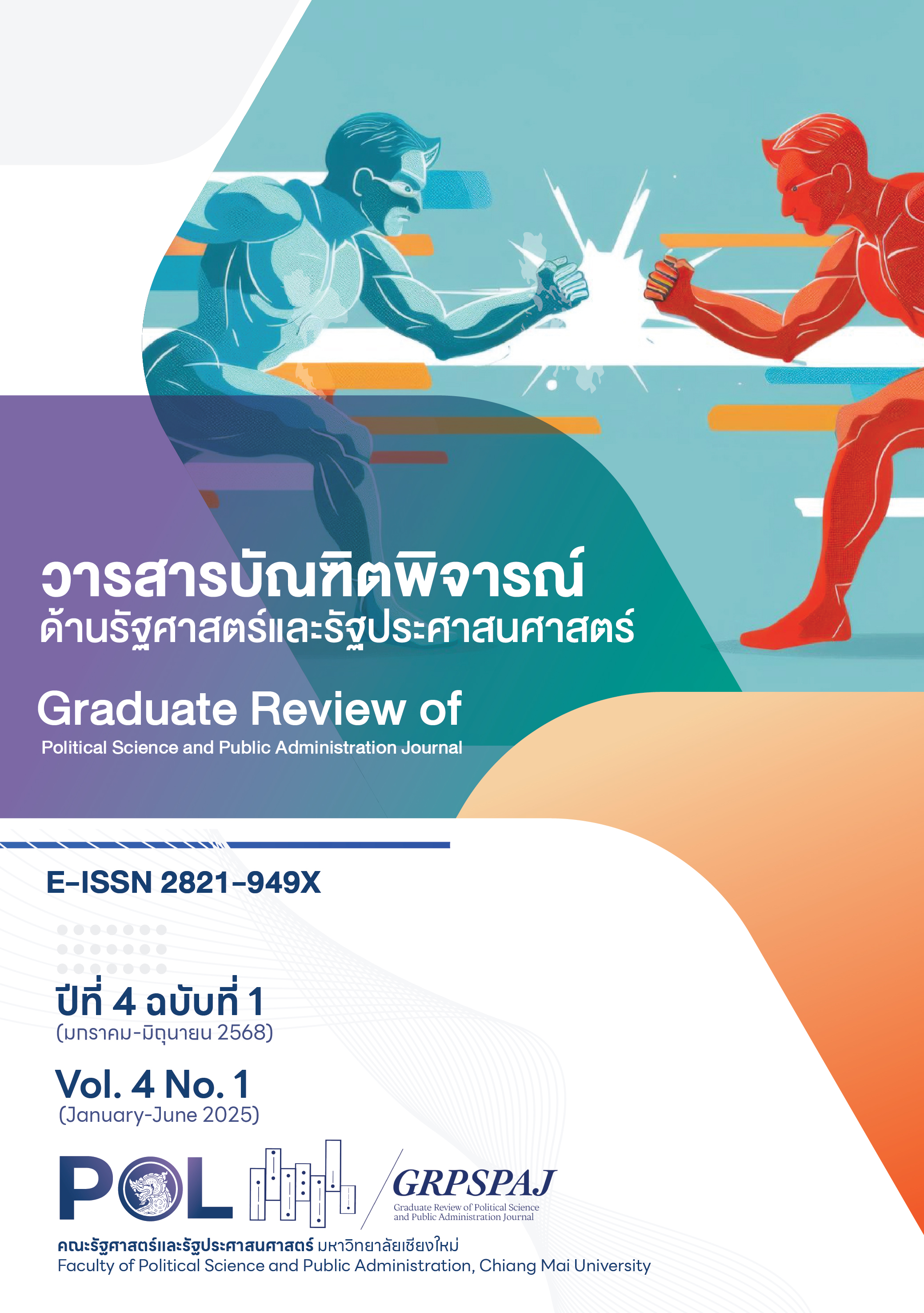ASEAN Cybersecurity Securitization: Regime of Cooperation and Enmity
Main Article Content
Abstract
This research aims to examine the key actors involved in the construction of the cybersecurity regime in the ASEAN region, as well as to study the factors and origins that drive the enforcement and maintenance of this regime. The study employs qualitative research through documentary analysis. The findings reveal that the main factors contributing to the construction of the ASEAN cybersecurity regime include securitizing actors such as ASEAN member states, international organizations, and civil society organizations. These actors play a crucial role in defining what constitutes a threat to regional security, influencing security discourse, and shaping ASEAN’s approach to addressing cybersecurity issues. Another key factor is the shared awareness of mutual threats, specifically, cyber threats which are transnational in nature, constantly evolving, and have significant impacts on both the economic and social dimensions of ASEAN. These threats also have cascading effects on other aspects of regional security, necessitating the development of various forms of cooperation within ASEAN and leading to the formation of the ASEAN cybersecurity regime. However, the ASEAN cybersecurity regime is not solely characterized by cooperation; it also embodies elements of cybersecurity enmity. This enmity arises from several factors, including the difference in interpretation, developmental disparities, political conflicts, and the involvement of external superpowers. The study suggests that ASEAN must develop a common approach to adapt in order to preserve regional security and stability, thus enabling its cybersecurity regime to grow in a stable, resilient, and sustainable manner. Future research can expand on this work by conducting in-depth studies of securitizing actors at the national level or by analyzing how external superpowers exert influence and play roles within the ASEAN’s cybersecurity landscape.
Article Details

This work is licensed under a Creative Commons Attribution-NonCommercial-NoDerivatives 4.0 International License.
Graduate Review of Political Science and Public Administration Journal is licensed under a Creative Commons Attribution-NonCommercial-NoDerivatives 4.0 International (CC BY-NC-ND 4.0) licence, unless otherwise stated. Please read our Policies page for more information...
References
กระทรวงดิจิทัลเพื่อเศรษฐกิจและสังคม. (2562). กระทรวงดิจิทัลฯ ร่วมประชุม รมต. อาเซียนด้านความมั่นคงปลอดภัยไซเบอร์ ที่สิงคโปร์ เดินหน้าบูรณาการร่วมกัน และกำหนดบรรทัดฐานความรับผิดชอบของรัฐบนโลกไซเบอร์. กระทรวงดิจิทัลเพื่อเศรษฐกิจและสังคม. https://www.mdes.go.th/news/detail/1740
ไทยพีบีเอส. (2560). ไทยโดนแล้ว 200 เครื่อง มัลแวร์เรียกค่าไถ่. ThaiPBS. https://www.thaipbs.or.th/news/content/262480
พระราชบัญญัติการรักษาความมั่นคงปลอดภัยไซเบอร์ พ.ศ. 2562. (2562). ราชกิจจานุเบกษา. เล่ม 136 ตอนที่ 69 หน้า 20-51.
สุภชาติ เล็บนาค. (2563). สื่ออาเซียนเผย “Fake News” เกี่ยวกับ "โควิด-19" หลายครั้ง “รัฐ” เผยแพร่เอง. Hfocus. https://www.hfocus.org/content/2020/04/19057
Agence France-Presse. (2024). Sweeping Vietnam Internet Law Comes into Force. Voice of America. https://www.voanews.com/a/sweeping-vietnam-internet-law-comes-into-force/7913333.html
Ang, B. (2018). Next Steps for Cyber Norms in ASEAN. S. Rajaratnam School of International Studies (RSIS). https://www.rsis.edu.sg/rsis-publication/cens/next-steps-for-cyber-norms-in-asean/
Aradau, C. (2004). Security and The Democratic Scene: Desecuritization and Emancipation. Journal of International Relations and Development, 7, 388-413. https://doi.org/10.1057/palgrave.jird.1800030
ASEAN Briefing. (2024). Indonesia's Comprehensive Personal Data Protection Law Guide. ASEAN Briefing. https://www.aseanbriefing.com/doing-business-guide/indonesia/company-establishment/personal-data-protection-law
ASEAN Defence Ministers' Meeting Plus. (2016). Concept Paper on the Establishment of the ADMM-Plus Experts’ Working Group on Cyber Security. ASEAN Defence Ministers’ Meeting (ADMM). https://admm.asean.org/dmdocuments/Concept%20Paper%20on%20Establishment%20of%20EWG%20on%20Cyber%20Security,%20Final,%20as%20adopted%20by%20the%2010th%20ADMM.pdf
ASEAN Foundation. (2023). ASEAN Foundation and Microsoft’s Cybersecurity Skilling Programme Benefited 24,886 People in ASEAN. ASEAN Foundation. https://www.aseanfoundation.org/asean_foundation_and_microsoft_s_cybersecurity_skilling_programmebenefited_24_886_people_in_asean
ASEAN Regional Forum. (2006). ASEAN Regional Forum (ARF) Statement on Cooperation in Fighting Cyber Attack and Terrorist Misuse of Cyber Space. ASEAN Regional Forum https://cil.nus.edu.sg/wp-content/uploads/2019/02/2006-ARF-Statement-on-Cyber-Attack.pdf
ASEAN Regional Forum. (2012). ASEAN Regional Forum (ARF) Statement by the Ministers of Foreign Affairs on Cooperation in Ensuring Cyber Security. ASEAN Regional Forum. https://aseanregionalforum.asean.org/wp-ontent/uploads/2019/01/ARF-Statement-on-Cooperation-in-Ensuring-Cyber-Security.pdf
ASEAN Secretariat. (2017). ASEAN Declaration to Prevent and Combat Cybercrime. The ASEAN Secretariat. https://asean.org/asean-declaration-to-prevent-and-combat-cybercrime/
ASEAN Secretariat. (n.d.). Cyber Security. The ASEAN Secretariat. https://asean.org/our-communities/asean-political-security-community/peaceful-secure-and-stable-region/cyber-security/ASEAN
ASEAN Youth Organization. (2023). ASEAN Cybersecurity Skilling Programme. ASEAN Youth Organization. https://aseanyouth.net/acsp/
ASEAN-Japan Cybersecurity Capacity Building Centre. (2023). ASEAN-Japan Cybersecurity Capacity Building Centre. AJCCBC. https://ajccbc.ncsa.or.th/about-us/
Brandon, J. J. (2018). Why ASEAN Needs to Invest More in Cybersecurity. The Asia Foundation. https://asiafoundation.org/why-asean-needs-to-invest-more-in-cybersecurity/
Buzan, B. (1998). Security: A New Framework for Analysis. Lynne Rienner Pub.
Caballero-Anthony, M. (2016). An Introduction to Non-Traditional Security Studies: A Transnational Approach. Sage Publications.
Cox, R. W. (1996). Approaches to World Order. Cambridge University Press.
Deibert, R. J. (2013). Black Code: Surveillance, Privacy, and the Dark Side of the Internet. Signal.
Ghosh, N. (2019). Singapore's Cyber Security Chief Says International Norms, Partnerships Are Key Issues. The Straits Times. https://www.straitstimes.com/singapore/singapores-cyber-security-chief-says-international-norms-partnerships-are-key-issues
Gohwong, S. (2019). The State of the Art of Cybersecurity Law in ASEAN. Asian Crime and Society Review, 6(2), 12-23. so02.tci-thaijo.org/index.php/IJCLSI/article/view/242594
Hansen, L. (2012). Reconstructing Desecuritisation: The Normative-Political in the Copenhagen School and Directions for How to Apply It. Review of International Studies, 38(3), 525-546. http://www.jstor.org/stable/41681477
Heinl, C. (2014). Regional Cybersecurity: Moving Toward a Resilient ASEAN Cybersecurity Regime. Asia Policy, 18, 131-159. https://dx.doi.org/10.1353/asp.2014.0026
Japan-ASEAN Integration Fund. (2022). Enhancing Cybersecurity Skills of Professionals in ASEAN. JAIF Management Team. https://jaif.asean.org/beneficiaries_voice/enhancing-cybersecurity-skills-of-professionals-in-asean/
Nasu, H., McLaughlin, R., Rothwell, D. R., & Tan, S. S. (2019). The Legal Authority of ASEAN as a Security Institution. Cambridge University Press. https://doi.org/10.1017/9781108669511
Nye, J. S. (2010). Cyber Power. Belfer Center for Science and International Affairs, Harvard Kennedy School. https://www.belfercenter.org/publication/cyber-power
Piiparinen, A. (2016). China’s Secret Weapon in the South China Sea: Cyber Attacks. The Diplomat. https://thediplomat.com/2016/07/chinas-secret-weapon-in-the-south-china-sea-cyber-attacks/
Sunkpho, J., Ramjan, S., & Oottamakorn, C. (2018). Cybersecurity Policy in ASEAN Countries. 17th Annual Security Conference, Information Institute Conferences. Las Vegas, NV.
The Irrawaddy. (2022). Myanmar Junta’s New Cyber Law to Jail Anyone Using VPN. The Irrawaddy. https://www.irrawaddy.com/news/burma/myanmar-juntas-new-cyber-law-to-jail-anyone-using-vpn.html
The Southeast Asia Freedom of Expression Network. (2024). About Us. Southeast Asia Freedom of Expression Network. https://safenet.or.id/about-us/
Van Raemdonck, N. (2021). Cyber Diplomacy in Southeast Asia. EU Cyber Direct. https://eucyberdirect.eu/research/cyber-diplomacy-in-southeast-asia
Waltz, K. N. (1979). Theory of International Politics. Addison-Wesley.
Woollacott, E. (2019). Days After Introduction of 'Cybersecurity' Law, Vietnam Has Facebook in Its Sights. Forbes Magazine. https://www.forbes.com/sites/emmawoollacott/2019/01/09/days-after-introduction-of-cybersecurity-law-vietnam-has-facebook-in-its-sights/
ASEAN. (2021). ASEAN Cybersecurity Cooperation Strategy (2021 – 2025). ASEAN. https://asean.org/wp-content/uploads/2022/02/01-ASEAN-Cybersecurity-Cooperation-Paper-2021-2025_final-23-0122.pdf
Tan, S. S. (2022, March 8). ASEAN Cyber Norms Need Broad Stakeholder Engagement. The Strategist. https://www.aspistrategist.org.au/asean-cyber-norms-need-broad-stakeholder-engagement/
Albahri, D. A. A. (2023, October 5). Women’s Civil Society and Digital Rights Groups Shape South-East Asian Digital Security Training. UN Women Asia-Pacific. https://asiapacific.unwomen.org/en/stories/news/2023/10/womens-civil-society-and-digital-rights-groups


